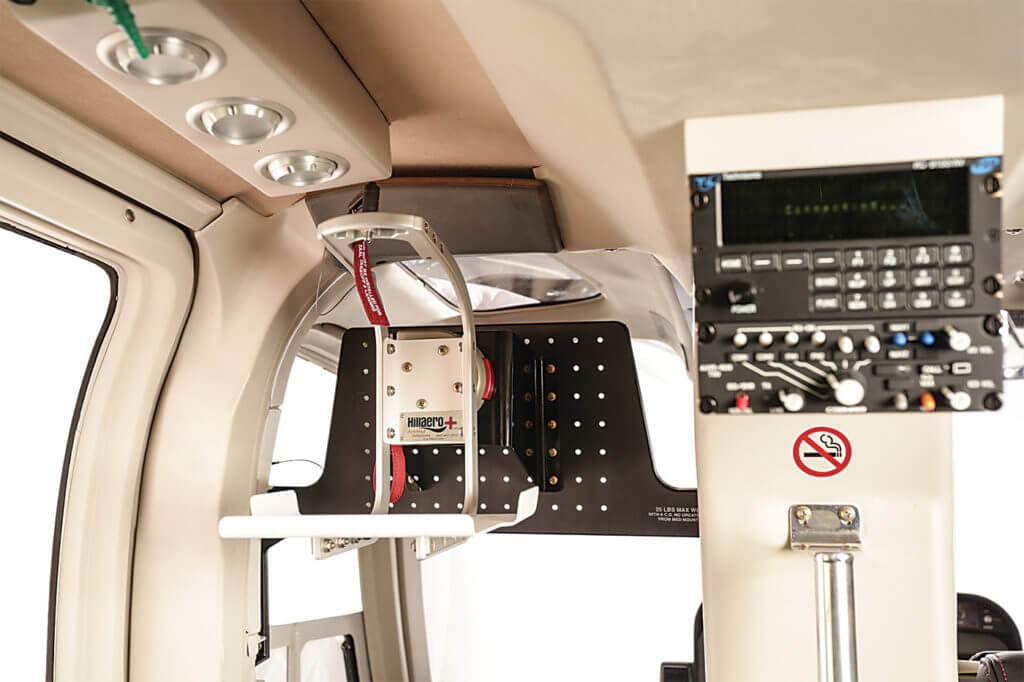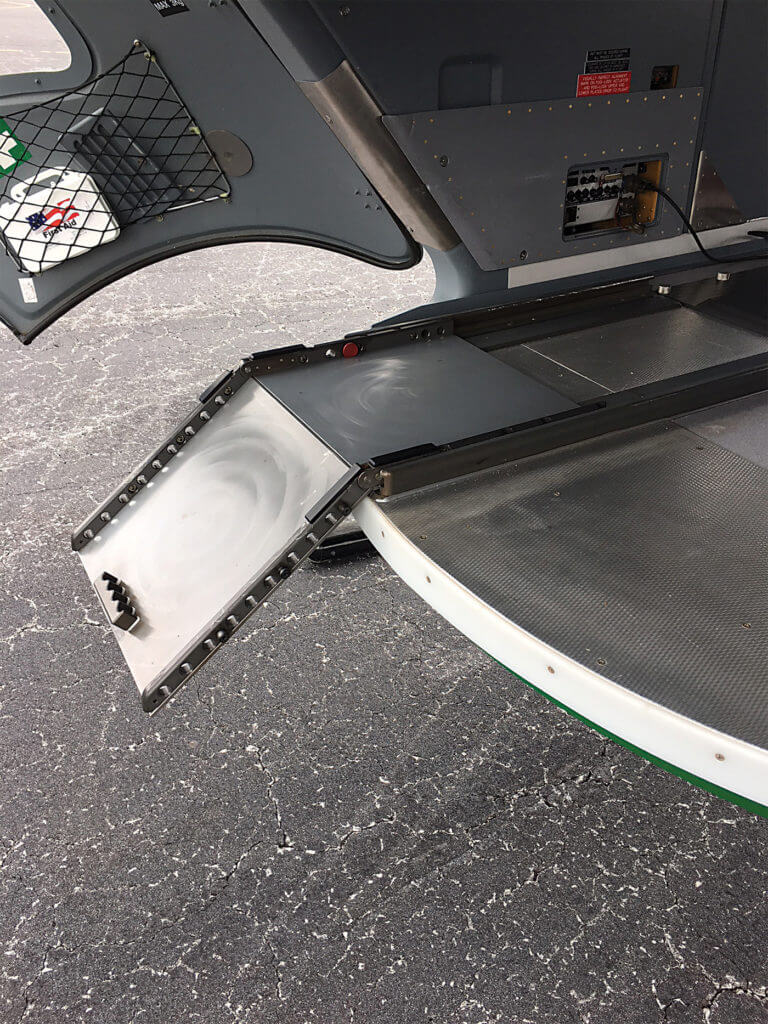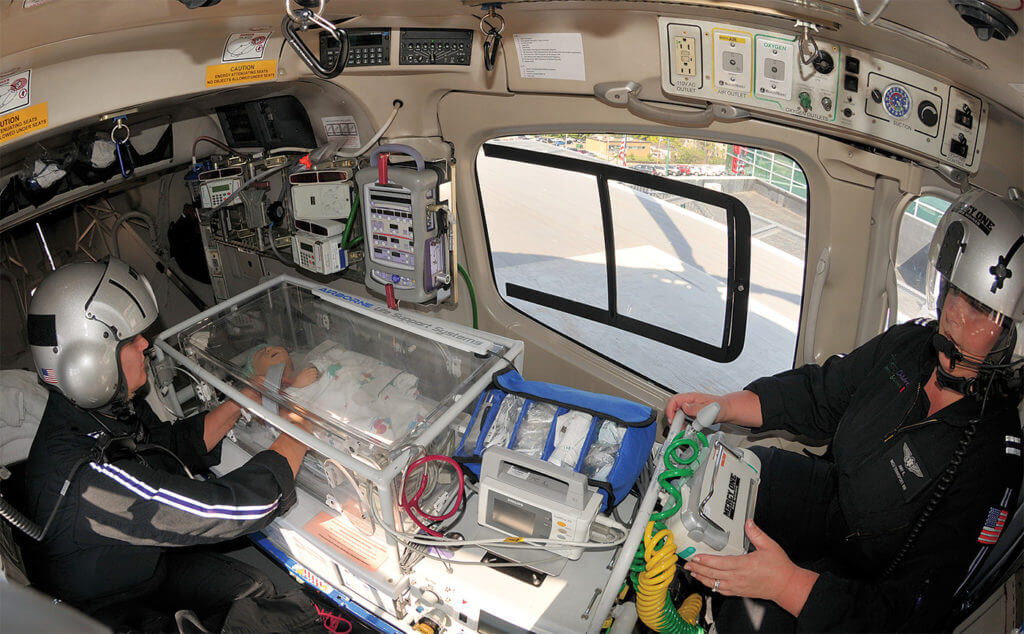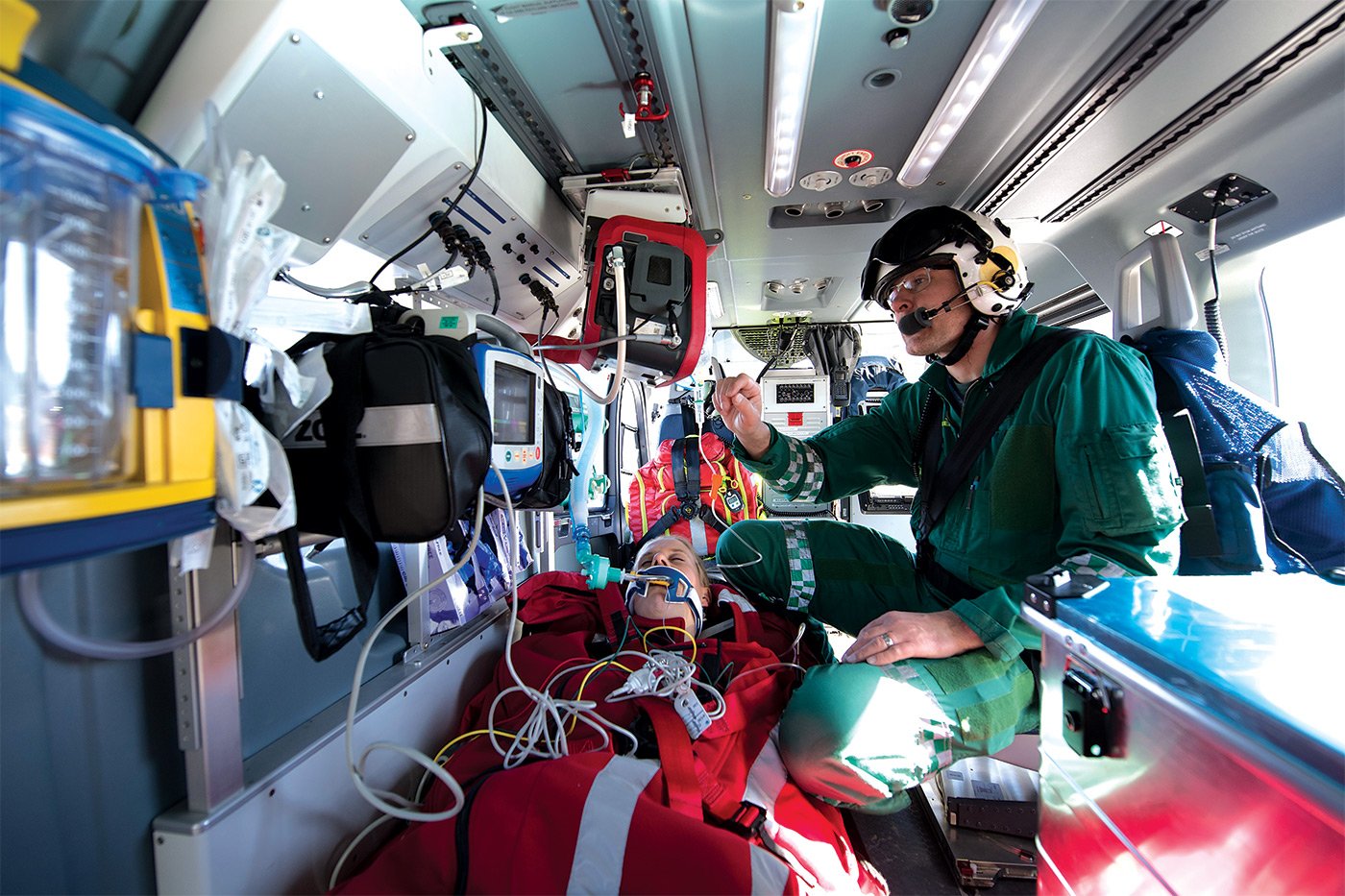When it comes to developments in helicopter medical interiors, it’s a case of evolution rather than revolution. The speed of innovation is governed in part by the cost and time involved in putting designs through the regulatory approval process, and also by the benefits to operators of having uniform designs across their fleets.

That said, there has been innovation in aspects such as materials and lighting as producers and customers of air medical interiors continue to seek lighter, more effective solutions.
Lightweight materials
Reduced weight continues to be a key feature that customers look for in an air medical interior, according to Hans Bretscher, vice president and general manager at Aerolite America. The company has put its efforts into developing lightweight interiors and components to satisfy this demand.
“Complete HEMS [helicopter emergency medical services] interiors for light twin helicopters that are currently implemented are below 150 kilograms/330 pounds,” he said. “Where hot-and-high search-and-rescue capabilities are prevalent, complete interiors weigh around 100 kg/220 lb.”
As Matthew Christenson, vice president and account executive at Spectrum Aeromed, explained, weight savings allow a crew to carry more medical devices or more fuel, which can change what they can do. And while the majority of components in medical interiors continue to be produced from machined aluminum, Spectrum Aeromed has been using carbon fiber in its medical interiors for several years.
As an example, the company employs carbon fiber to make light, durable helicopter flooring. The company is exploring additional applications, said Christenson; the next step would be to do more with the main base unit of the stretcher. Alongside the potential for significant weight savings, he noted that using carbon fiber can allow the creation of shapes not possible with aluminum.

Mike Slattery, president of United Rotorcraft, cautioned that the low production rates for EMS interiors could result in a high unit cost for carbon-fiber construction. For another route to produce otherwise impossible shapes, how about 3D printing? Such “additive manufacturing” could also provide weight savings, although the effort and cost of achieving certification may be prohibitive, said Slattery. However, it’s a technology that United Rotorcraft is monitoring as a possible option in the future.
Flexible solutions
According to Slattery, while some customers are looking for lighter, simpler interiors at lower cost, others need to be able to complete a range of complex missions with perhaps more team members and equipment (think isolettes and balloon pump transports) where the main concern may be functionality, not weight. He also noted that there is growing demand for interiors that can be easily reconfigured for different mission types, such as swapping from EMS to a special mission or passenger transport configuration.
For example, in July, United Rotorcraft gained European Aviation Safety Agency (EASA) certification for Leonardo AW139 and AW169 interiors that allow for easy installation and removal of seats, which can either be seats intended to transport passengers in comfort or flip-up seats that facilitate patient loading. A more extreme example of this reconfigurability is a Sikorsky S-70 Firehawk interior that can be set up for EMS litter transport, firefighting, crew transport or cargo flights, thanks not least to seats that fold down from the ceiling as required.
Cool lighting
LEDs have long been the light source of choice onboard medical aircraft, thanks to their low weight, reliability, high output and low power consumption. They also run cool, a potential advantage for the medical crew operating in a cramped cabin (just ask the medevac doctor who according to LEDtronics Inc. seared his hand on a hot halogen light bulb that then burnt out, prompting the Royal Danish Air Force to switch to LEDs back in 2004).
Slattery of United Rotorcraft said that the shift to LEDs for both interior and exterior lighting has been happening for a number of years. It’s an ongoing process, he said, noting that any lighting changes require certification.
Thanks to the widespread use of night vision goggles (NVGs), interior lights are typically filtered to be NVG-compatible, which can result in a blue-green cast. However, that could be changing.

AeroBrigham has been installing NVG-compatible LED lighting in medical helicopters for at least the past 10 years, said owner and president David Brigham. Some 18 months ago, the company introduced a unit that provides a bright, white light that’s NVG-compatible right out of the box, no filter required. It took some time to convince the NVG makers, said Brigham, but these days the firm employs the light for helicopter cabin illumination in all of its medical completions.
Medical mounts
A far less visible, but no less important, element of these interiors can be found in the mounts to secure medical equipment. Christenson of Spectrum Aeromed reflected that working on new mounts is a continuous process, given the ever-changing range of devices available to crews.
Most of the customers of Wysong Enterprises prefer to keep their aircraft standardized for training purposes, pointed out Steve Wysong, president. However, mounts are an area where customers do request changes, he said: “We do get requests now and then to mount a different medical monitor in the rear cabin of the [Bell] 407 . . . The monitor mounts are approved in a way that if a current medical piece of equipment is changed, we can adapt those items to the STC [supplemental type certificate] mounting brackets easily.”
Giving a specific example, Kristen King Holmes, director of marketing for Metro Aviation, commented that ultrasound equipment is becoming more mainstream and customers are increasingly asking for ways to secure it in the aircraft.
Meanwhile, David Brigham for one is seeing a trend of moving away from mounting equipment to the interior. Observing that certifying new mounts is an expensive process, he said that AeroBrigham is increasingly seeing operators opt to take medical devices as carry-on equipment, either strapped to a seat or on the stretcher with the patient. He noted that much of this modern equipment is very lightweight, giving the example of defibrillators weighing just a couple of pounds that can be put between a patient’s legs.
New markets
A clear shift that is occurring is in the geographic location of customers seeking helicopter medical interiors. Hans Bretscher of Aerolite America explained, “We see growing demand for HEMS interiors, not only from our existing customers in North America and Europe but also from operators in the Pacific Rim countries, China and South America. Operators in these countries demand the same sophistication in their HEMS capabilities as requested by our customers with established and long-running operations.”

This July, United Rotorcraft completed its first EMS Bell 407 for the Chinese market. Mike Slattery asserted that in the future, China will be the biggest market for rotor-wing aircraft. Speaking of the process of gaining approval from the Civil Aviation Administration of China (CAAC), Slattery explained that the CAAC analyzed the Federal Aviation Administration STC data packages as the basis of certification.
New aircraft?
It’s to be expected that as new helicopter models come onto the market, medical interiors will be developed so they can be employed in the air ambulance sector.
Bretscher commented, “With new or updated helicopters coming to market and being introduced, Aerolite is constantly answering to development trends such as roll-in stretchers, stretcher pack rack capabilities that are certified for all phases of flight, and customer-demanded integrations of sophisticated medical equipment such as balloon pumps, ultrasonic and ECMO [extracorporeal membrane oxygenation] equipment.”
United Rotorcraft gained EASA certification for its modular AW169 and AW139 interiors just this August. Speaking at the time, Frank Graham, senior director of global sales and marketing, said: “The AW169 and AW139 configurations allow for a head attendant seat, which is a cornerstone to patient care and access.”
Although the AW139 is hardly a new model, the AW169 has only recently begun gaining traction in the EMS market. While the release of an interior may follow on the heels of the introduction of a new model, in some cases the medical design work gets underway ahead of the launch of the aircraft. For example, Holmes revealed that Metro Aviation is already hard at work on a proposal for a medical interior for the Airbus H160 helicopter, EASA certification of which isn’t now expected until late 2019.
Meanwhile, both Metro and AeroBrigham report that growing numbers of operators are spurning factory deliveries and turning to pre-owned aircraft. Commenting on Metro’s experience, Holmes said: “Another big trend is refurbishments instead of people purchasing new aircraft. About half of this year’s completions have been refurbished aircraft.”

Meanwhile, Brigham said that over the last three years in particular, his firm has been helping start-ups to source used single-engine helicopters, adding that even with repainting, reconfiguring and thorough mechanical servicing, the price tag for a pre-owned machine might be some two-thirds lower than for a new machine. Smaller start-ups in particular are adopting single-engine helicopters, he said, as they favor models that are cheap to acquire and operate as they look for ways to compete in the marketplace.
Customer demand
At Metro Aviation, there have been changes in the equipment that customers are looking for, explained Holmes. “As far as loading goes, we’ve developed a ramp for the H135. It’s been available for a couple of years, but we’ve seen an increase in requests for it. It assists with loading the patient stretcher into the aircraft and was originally designed for an overseas customer that was having trouble getting the stretcher into the aircraft,” she said.
One current area of work at Metro involves accommodating Stryker EMS stretchers, she added: “We’re developing a Stryker Performance manual load solution for the H145.”
It’s fair to say that while most of the work in helicopter medical completions involves work on the interior, some of the changes that providers like Metro are seeing are located outside the cabin or involve communicating with staff on the ground. For example, said Holmes, Metro has seen a rise in the number of requests for external cameras fitted in the tailboom area.
And the company is coming to the end of a project to install IRIS, a flight data monitoring, tracking and communications solution from Outerlink Global Solutions that among other things will allow medical crews to transmit live electrocardiogram data to receiving hospitals while the patient is still in flight.

Said Holmes, “We are outfitting all of our ops aircraft with IRIS. We plan to have the entire fleet done by the end of the year.”






HAA or Helicopter Air Ambulance is now the appropriate acronym or term for these type aircraft and operations.
While the FAA has ignored the most pertinent recommendations from the NTSB to improve HEMS safety (NVGs, Autopilots, mandatory IIMC training) – HAA ie Helicopter Air Ambulance is an acronym invented and used soley by the FAA in a ridiculous attempt “to make the industry safer” . If we dont say “emergency” everything will be better. It is purely an American aviation term – not recognized by anyone but the FAA.
I love what you said about new helicopter models and how they are expected to come onto the market. Medical flights are vital in dire situations that require immediate rescue and transportation to a hospital. If I ever find myself in such a situation, I would make sure to contact a medical flight service that is known for its speed and efficiency.